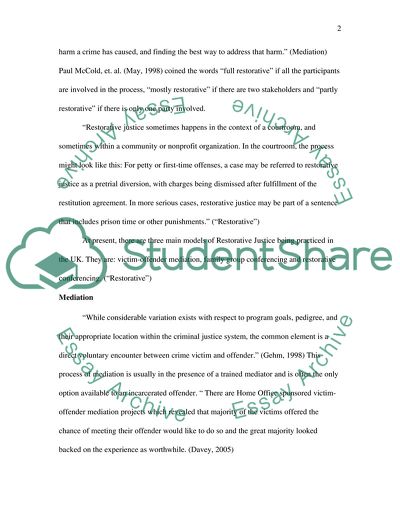Cite this document
(“CRIMINAL BEHAVIOUR - RESTORATIVE JUSTICE VICTIM OFFENDER MEDIATION, Essay”, n.d.)
CRIMINAL BEHAVIOUR - RESTORATIVE JUSTICE VICTIM OFFENDER MEDIATION, Essay. Retrieved from https://studentshare.org/miscellaneous/1536422-criminal-behaviour-restorative-justice-victim-offender-mediation-positive-impact-consideration-of-victims-in-cjs-negative-impact-does-restorative-justic
CRIMINAL BEHAVIOUR - RESTORATIVE JUSTICE VICTIM OFFENDER MEDIATION, Essay. Retrieved from https://studentshare.org/miscellaneous/1536422-criminal-behaviour-restorative-justice-victim-offender-mediation-positive-impact-consideration-of-victims-in-cjs-negative-impact-does-restorative-justic
(CRIMINAL BEHAVIOUR - RESTORATIVE JUSTICE VICTIM OFFENDER MEDIATION, Essay)
CRIMINAL BEHAVIOUR - RESTORATIVE JUSTICE VICTIM OFFENDER MEDIATION, Essay. https://studentshare.org/miscellaneous/1536422-criminal-behaviour-restorative-justice-victim-offender-mediation-positive-impact-consideration-of-victims-in-cjs-negative-impact-does-restorative-justic.
CRIMINAL BEHAVIOUR - RESTORATIVE JUSTICE VICTIM OFFENDER MEDIATION, Essay. https://studentshare.org/miscellaneous/1536422-criminal-behaviour-restorative-justice-victim-offender-mediation-positive-impact-consideration-of-victims-in-cjs-negative-impact-does-restorative-justic.
“CRIMINAL BEHAVIOUR - RESTORATIVE JUSTICE VICTIM OFFENDER MEDIATION, Essay”, n.d. https://studentshare.org/miscellaneous/1536422-criminal-behaviour-restorative-justice-victim-offender-mediation-positive-impact-consideration-of-victims-in-cjs-negative-impact-does-restorative-justic.


